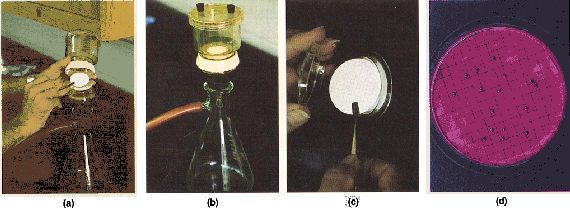
An important aspect of public health is the detection of sewage in water supplies and other bodies of water having contact with humans. It is worth understanding how this detection is done.
It is virtually impossible to test for each specific pathogen that might be present. Therefore, an indirect method called the fecal coliform test has been developed. This test is based on the fact that huge populations of a bacterium called E. coli (Escherichia coli) normally inhabit the lower intestinal tract of humans and other animals, and large numbers of the bacterium are excreted with fecal material. In
temperate regions at least,E. coli does not last long in the outside environment.
Therefore, the presumption is that when E. coli is found in natural waters, it indicates recent and probably persisting contamination with sewage wastes. In most situations, E. coli is not a pathogen itself but is referred to as an indicator organism. Its presence indicates that water is contaminated with fecal wastes and that sewage-borne pathogens may be present. Conversely, the absence of E. coli is taken to mean that water is free from such pathogens.
The fecal coliform test, one technique of which is shown in the
figures here, detects and counts the number of coliform bacteria in a sample of water. Thus, the results indicate the relative degree of contamination and the relative risk of pathogens. For example, to be safe for drinking, water should have an average E. coli count of no more than one E. coli per 100 milliliters (about 0.4 cups) of water. Water with as many as 200 E. coli per 100 mL is still considered safe for swimming. Beyond that level, a river may be posted as polluted, and swimming and other direct contact should be avoided. By comparison, raw sewage (99.9% water, 0.1% waste) has E. coli counts in the millions.

Testing water for sewage contamination-the Millipore technique. (a) A Millipore filter disk is placed in the filter apparatus. (b) A sample of the water being tested is drawn through the filter, and any bacteria present are entrapped on the filter disk. (c) The filter disk is then placed in a petri dish on a special medium that supports the growth of bacteria and will impart a particular color to fecal E. coli bacteria. The dish is then incubated for 24 hours at 38°C, during which time each bacterium on the disk will multiply to form a colony visible to the naked eye. (d) Escherichia coli bacteria, indicating sewage contamination, are identifiable as the colonies with a metallic green sheen.